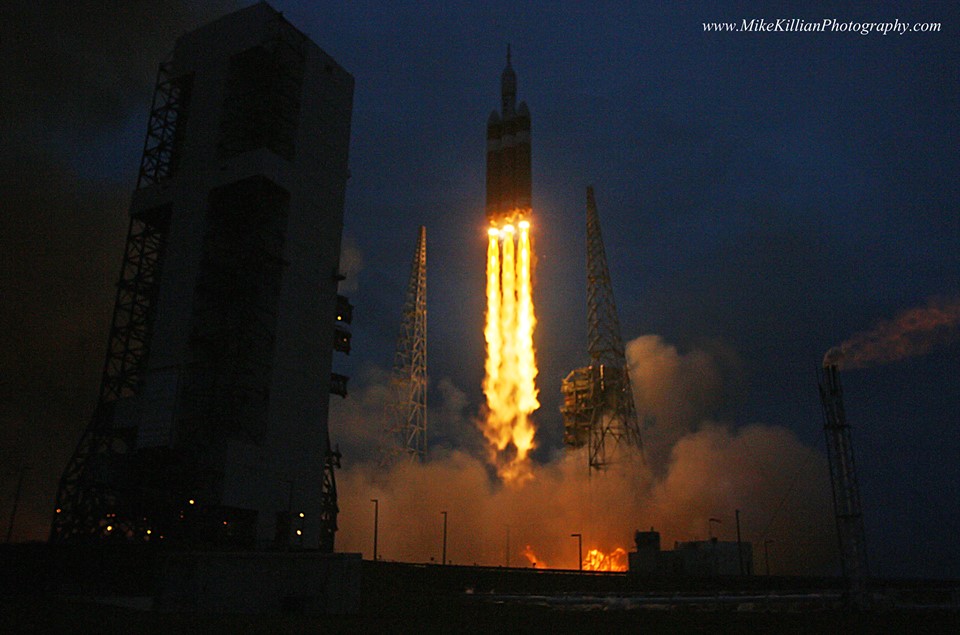
After an agonizing 24-hour delay, the ground shook at Cape Canaveral Air Force Station today, with the rousing liftoff, just minutes after sunrise, of United Launch Alliance’s (ULA) Delta IV Heavy, the largest and most powerful rocket currently in active operational service, anywhere in the world. Liftoff took place at 7:05 a.m. EST Friday, from Space Launch Complex (SLC)-37B. For the eighth time since December 2004, the three Common Booster Cores (CBCs) of this beast pumped out a combined 2.1 million pounds (960,600 kg) of propulsive yield to deliver a heavyweight payload into space. For the eighth time, its trio of RS-68 liquid oxygen/hydrogen main engines functioned without incident, for the eighth time it successfully delivered its primary payload to orbit, and for the eighth time its Delta Cryogenic Second Stage (DCSS) performed with near-perfection. But on Friday, 5 December 2014, just 16 days shy of the 10th anniversary of its maiden voyage, the Heavy executed perhaps the most dramatic, exciting, and far-reaching mission of its career to date, by delivering Orion—the first human-capable spacecraft for Beyond Earth Orbit (BEO) exploration in more than four decades—on its inaugural shakedown flight.
“Today’s flight test of Orion is a huge step for NASA and a really critical part of our work to pioneer deep space on our Journey to Mars,” said NASA Administrator Charles Bolden. “The teams did a tremendous job putting Orion through its paces in the real environment it will endure as we push the boundary of human exploration in the coming years.”
As described in AmericaSpace’s two-part preview article last weekend, the Exploration Flight Test (EFT)-1 mission marks the maiden voyage of Orion, which NASA hopes will spearhead U.S. ambitions to expand a human presence beyond low-Earth orbit, to the Moon, perhaps to near-Earth asteroids, and ultimately as far afield as Mars. The program to develop the vehicle was first conceived in President George W. Bush’s Vision for Space Exploration (VSE), unveiled in January 2004. Originally named the Crew Exploration Vehicle (CEV), it was renamed “Orion” in August 2006, but both it and its umbrella “Constellation Program” met with political opposition and inadequate funding and were terminated by President Barack Obama in 2010. However, development of Orion continued and in May 2011 it was “reborn” as the Multi-Purpose Crew Vehicle (MPCV). Six months later, the EFT-1 mission was baselined as a means of demonstrating the spacecraft’s capacity to endure the high radiation environment of the lower Van Allen Belts and survive a re-entry in excess of 20,000 mph (32,000 km/h). This velocity is far higher than the 17,500 mph (28,800 km/h) experienced during shuttle re-entries and is markedly closer to the speeds that Orion would encounter during a return from lunar distance.
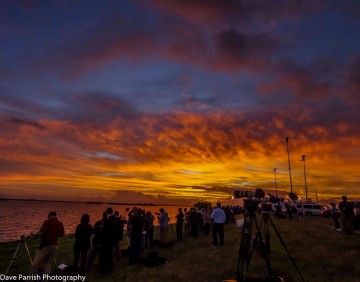
The Delta IV Heavy was transferred from the Horizontal Integration Facility (HIF) to the SLC-37B pad surface on 1 October and was joined by the Orion payload and its attached Launch Abort System (LAS) on the night of 11/12 November to begin final pre-flight preparations. In spite of an increasingly gloomy prospect of acceptable weather at the Cape, with cloudy skies, a 30 percent likelihood of rain and a 10 percent chance of lightning—which produced an overall forecast of just 60 percent probability that an on-time launch could be achieved—NASA and ULA managers, together with Orion’s prime contractor, Lockheed Martin, pressed smartly through the Flight Readiness Review (FRR) and Launch Readiness Review (LRR) milestones and secured Eastern Range approval for back-to-back launch opportunities on Thursday, 4 December, and Friday, 5 December. Both days featured expansive, 159-minute “launch windows,” opening at 7:05 a.m. EST, just five minutes after local sunrise, and closing at 9:44 a.m., thereby offering ample time to accommodate weather-related or technical issues.
In anticipation of the opening attempt, the 300-foot-tall (100-meter) Mobile Service Tower (MST) was dramatically retracted from the vehicle at 11:00 p.m. EST Wednesday, exposing the Delta IV Heavy and its crowning glory, the bulbous Orion/LAS stack, to the elements and the lenses of photographers for the first time. Two hours later, Orion was powered-up and the ULA Launch Team received its formal Call to Stations at 1:35 a.m. Thursday. Shortly thereafter, the Mission Management Team (MMT), based at Cape Canaveral Air Force Station and chaired by Lockheed Martin’s Mission Manager (and former shuttle program flight director) Bryan Austin, and the NASA Flight Control Team, stationed at the Johnson Space Center (JSC) in Houston, Texas, and overseen by Flight Director Mike Sarafin, also came onto their consoles. Their deliberations were punctuated, just under two hours before T-0, by a briefing from the National Oceanic and Atmospheric Administration (NOAA) Spaceflight Meteorology Group about weather conditions at Orion’s primary recovery location in the Pacific Ocean, about 600 miles (965 km) off the west coast of Baja California. Alongside this report, the 45th Space Wing at the Cape provided its own update on weather conditions in anticipation of launch.
Shortly after 2:20 a.m., the SLC-37B pad area was cleared of all personnel and, following polls from the ULA launch team, the three-step process of fueling the Delta IV Heavy with liquid oxygen and liquid hydrogen got underway. This followed a similar protocol to that employed on the giant booster’s seven previous missions between December 2004 and August 2013. “Initially, the tanks and ground equipment are chilled down. This is followed by the fuel transfer lines and valves. The chilldown is required to prevent thermal shock when the supercold liquid fuels pass through the various components,” explained AmericaSpace’s Launch Tracker, which was jointly managed for EFT-1 by Mike Barrett and Leonidas Papadopoulos. “After chilldown, the tanks will start to be filled. Initially, there will be a fast flow of fuels until the tanks are nearly full. At this point, the fueling will transition to replenishment mode, where the tanks are continuously topped off to maintain flight levels. This replaces any of the liquids that may boil off during the countdown.”
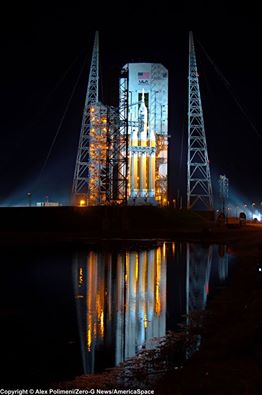
Each Common Booster Core stands 134 feet (40.8 meters) tall and the central core was topped by the 16-foot-wide (5-meter) Delta Cryogenic Second Stage (DCSS) and dedicated Orion payload fairing, with the entire vehicle weighing approximately 1.6 million pounds (725,750 kg). The fueling process saw more than 440,000 pounds (200,000 kg) of cryogenic propellants loaded into the three CBCs, each of which was powered by a single RS-68 main engine, built by Pratt & Whitney Rocketdyne. When the RS-68 was introduced, back in 2002, it became the first large, liquid-fueled powerplant to be developed in the United States since the Space Shuttle Main Engine (SSME).
During the fueling process, the weather conditions steadily brightened from 60 percent to 70 percent favorable, and, by 6:50 a.m., as the first wisps of sunbreak cast beautiful streaks of orange and yellow across the sky and across the marshy Florida landscape, the partly cloudy outlook did nothing to violate any Launch Commit Criteria (LCC). The only point of note was a possible infringement of liftoff wind speeds, but the weather was declared “Green” (“Go”). As planned, the clock halted for its final, built-in hold at T-4 minutes at 6:46 a.m., with the expectation that—if everything continued to run smoothly—it would be released at 7:01 a.m. to enter the Terminal Countdown and achieve an on-time liftoff at 7:05.
However, during the hold period, the Eastern Range declared itself “Red” (“No-Go”), on account of a boat having strayed into the waters of the launch exclusion zone. Although this brought back unpleasant memories of a similar delay which preceded the ill-fated launch of Orbital Sciences’ Antares booster in October, it was very quickly cleared and a revised T-0 of 7:17 a.m. was established. Orion transitioned to its internal batteries and external power utilities from SLC-37B were disconnected at 7:09 a.m. and the countdown clock was duly released from the T-4 minute hold at 7:13 a.m. As the seconds ticked away, ordnance aboard the Delta IV Heavy was armed, but the clock stopped again at 7:14 a.m., due to winds gusting at close to LCC redlines. At about the same time, the first significant technical issue—a vent valve anomaly—reared its head, but was soon rectified and at 7:45 a.m. a new T-0 time of 7:55 a.m. was established.
Orion was again returned to internal power and a definitive “Go for Launch” was declared by Launch Conductor Scott Barney of ULA. For the second time, the Delta IV Heavy’s ordnance was armed, and as the countdown pushed closer to T-0, the propellant tanks in the three CBCs were secured and pressurized for flight. Then, at 7:52 a.m., another hold was called, caused by an automatic script which detected another gust of wind, which violated LCC rules. The clock was recycled to T-9 minutes and although there remained sufficient time within the launch window, another technical problem arose in the form of an upward-trending temperature fault on an engine bearing in one of the CBCs. After investigation, it was determined that the bearing lay within acceptable limit bands and the prognosis for a successful resumption of the countdown reverted to “Green.”
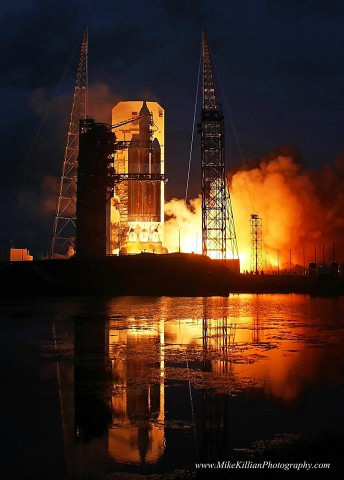
A new T-0 of 8:26 a.m. was set and, for the third time, the clock emerged from the hold at T-4 minutes and ticked its way through the Terminal Countdown. Again, ordnance aboard the vehicle was armed. Again, the tanks in the CBCs were secured and pressurized for flight. Yet, again, the hands of fate turned on the Heavy and on Orion. At 8:24 a.m., another hold was called, due to an indication that the fuel fill-and-drain valve had not closed properly. “This has been seen on the Delta IV rockets before,” noted AmericaSpace’s Launch Tracker. “The anomaly team recommend five open-and-close cycles of the valves prior to clearing the alert.” All three CBCs passed their hydrogen cycles, but the oxygen valves remained questionable. Efforts were made to pressurize the liquid hydrogen tanks in an effort to free up the valves, but by this stage—about 9:10 a.m.—the winds at the Cape began to pick up and posed their own threat to the LCC rules. The issue with the valves remained troublesome. “The latest attempt to clear the valve issue has failed,” the Launch Tracker reported at 9:26 a.m., “and the anomaly team are now recommending to return to a reduced fast-fill LH2 mode, followed by a 5-cycle manual open/close of the fill-and-drain valves.”
Despite the dwindling time available, there still existed a last-ditch hope to send Orion on its way at 9:44 a.m., right at the end of Thursday’s 159-minute window. Sadly, it was not to be. It had already been noted that the clock would only be released from the hold at T-4 minutes if the valve issue had been resolved, but long before that stage could be reached, at about 9:35 a.m., it became obvious that more time was needed by ULA engineers and the attempt was scrubbed.
A 24-hour turnaround was duly set in motion, tracking a second launch opportunity at 7:05 a.m. EST Friday, at the start of another 159-minute window, and the process of calling the teams to their stations and fueling the Delta IV Heavy continued in a similar fashion to Thursday’s abortive attempt. By 5:00 a.m., the 45th Weather Squadron reported that weather conditions at the Cape were “Red” (“No-Go”), on account of cumulus clouds and rain over the launch site, although this was expected to clear about an hour ahead of T-0. Indeed, by 5:50 a.m., conditions had turned “Green” (“Go”), but it was cautioned that the overall outlook stood at just 40-percent favorable. By 6:15 a.m., following the completion of fueling, the Heavy’s tanks transferred to replenishment mode and the countdown clock halted, as planned at 6:46 a.m., for the final built-in hold at T-4 minutes.
During this period, Flight Director Mike Sarafin polled his 14-member team at JSC for their consensus and was greeted by “Go” calls across the board, which he relayed to Mission Director Bryan Austin at the Cape. With 15 seconds to go, the Radial Outward Flame Igniters (ROFIs) were activated in order to burn off excess gases dumped through the Delta IV Heavy’s nozzles, prior to ignition. The three RS-68 engines themselves came to life at T-5 seconds, each ramping up to its maximum 705,900 pounds (320,200 kg) of thrust. After telemetry data had confirmed that the start-up sequence was satisfactory and within required parameters, the liftoff command was issued and the stack departed SLC-37B precisely on time at 7:05 a.m. EST, right on the opening of the launch window. As seen during previous Heavy launches, the enormous amount of hydrogen being dumped through the engines to condition them, ahead of the opening of liquid oxygen valves and the onset of the ignition sequence, generated an enormous fireball, which—although a little disconcerting to watch—was entirely nominal.
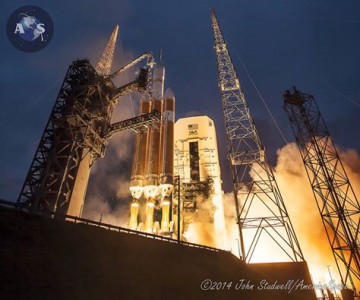
“Liftoff,” came the announcement as the behemoth rose from Earth, “at dawn … the dawn of Orion and a new era of American space exploration!”
Seconds after clearing the SLC-37B tower, the Heavy executed a computer-commanded pitch, yaw, and roll program maneuver. Pitch and yaw controllability was effected by gimbaling the engines themselves, whilst roll was accomplished by vectoring the turbine exhaust gases of the RS-68s. This actively guided the gigantic vehicle onto its proper heading and 95.0-degree flight azimuth to deliver Orion on the first leg of its journey, initially into low-Earth orbit. Fifty seconds into the ascent, the core CBC throttled back to about 57 percent of rated performance, in order to conserve propellant. The stack passed through a region of maximum aerodynamic turbulence upon its airframe (colloquially known as “Max Q”) at T+83 seconds and hit Mach 1 shortly thereafter at T+85 seconds. “Orion and Delta IV now transcending the speed of sound!” came the call from the ascent commentator, a few seconds after 7:06 a.m.
By three minutes and 50 seconds after leaving the Cape, the thrust of the two strap-on CBCs was also reduced to 57 percent and they shut down and separated from the rapidly ascending vehicle about seven seconds later. By running at 57 percent for the early phase of the ride uphill, the core thus had sufficient remaining propellant to support its own flight after the departure of the boosters. At T+246 seconds, its RS-68 engine throttled back up to 100-percent rated performance and burned for another 80 seconds, shutting down at T+330 seconds—some 5.5 minutes into the flight—and separating soon afterwards.
The turn then came for first of two “burns” by the restartable DCSS second stage and its single oxygen/hydrogen-fueled RL-10B2 engine, capable of 24,750 pounds (11,225 kg) of thrust. This roared to life at 7:10 a.m., about five minutes and 50 seconds after liftoff, and burned for close to 12 minutes, its specific impulse enhanced by means of an electrically-driven extendable carbon-carbon nozzle. The DCSS also housed the Delta IV Heavy’s avionics, navigation, telemetry and communications systems and has the potential to remain “active” for more than seven hours during extended-duration mission profiles, as well as executing Contamination and Collision Avoidance Maneuvers after the departure of its primary payload.
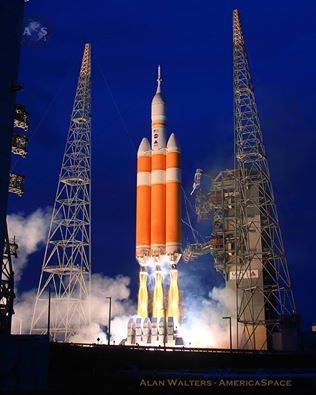
During the course of the initial DCSS burn, the three protective fairing panels—each measuring 13 x 14 feet (3.9 x 4.3 meters)—were jettisoned from around the sides of Orion’s Service Module and the now-unneeded LAS was also discarded. At 7:22:39 a.m. EST, some 17 minutes and 39 seconds after departing the Cape, the RL-10B2 engine fell silent, having established the EFT-1 spacecraft into an initial orbit of 115 x 552 miles (185 x 888 km), inclined 28.8 degrees to the equator. The stack then drifted for a further 98 minutes, or slightly more than one full orbit of Earth, before the DCSS ignited a second time for the lengthy “Big Burn” to boost Orion to its peak apogee of 3,600 miles (5,800 km) and a location 15 times further into space than the orbit of the International Space Station (ISS).
As will be described in tomorrow’s AmericaSpace history article, his made EFT-1 very similar in profile to the planned, but ultimately unrealized Apollo “E” mission and marked the furthest a human-capable craft has ventured from Earth since December 1972.An hour into the mission, the combined Orion Crew Module and Service Module, which remained attached to the DCSS throughout the flight, was established in a slow “barbecue roll” to keep temperatures balanced across its external surfaces. Then, at 9:00:26 a.m. EST, a little less than two hours since launch, the DCSS ignited for the “Big Burn,” which ran for four minutes and 43 seconds and served to raise the stack’s apogee through the Lower Van Allen Belt, part of Earth’s protective geomagnetic field, which extends from roughly 600 miles (1,000 km) to 3,700 miles (6,000 km) above the surface. Beyond the belts, spacecraft are more susceptible to the effects of cosmic rays and solar flare radiation, which is known to damage solar cells, integrated circuits, and electronic components.
Five minutes after the DCSS shut down for the second time, at about 9:10 a.m., Orion entered its First High Radiation Period, passing into the Lower Van Allen Belt, during which time its cameras—which had relayed spectacular views of its ascent to a terrestrial audience—were temporarily shut down to avoid damage. The spacecraft will rose above this particularly intense radiation neighborhood by 9:25 a.m., after which its cameras were switched back on and, shortly afterwards, its Reaction Control System (RCS) was powered up. Orion reached its peak apogee of 3,609 miles (5,808 km) at 10:11 a.m.—approximately three hours and six minutes into the mission—which placed a human-capable vehicle further from the Home Planet for the first time in almost 42 years. At this altitude, the view of Earth was spectacular, filling 60 percent of Orion’s windows and resembling a six-foot-wide (1.8-meter) disk, held at arm’s length.
What goes up, however, must come down, according to the adage, and after apogee Orion began its downhill journey back to the waters of the Pacific Ocean, where recovery teams from the USS Anchorage and the USNS Salvor were stationed, about 600 miles (965 km) southwest of San Diego. After hitting the peak of its high-apogee orbit, Orion’s Crew Module shed the DCSS/Service Module stack was jettisoned at 10:30 a.m. This enabled the Crew Module—the sole part of Orion which is capable of surviving re-entry—to begin its descent back through the “sensible” atmosphere. In addition to the blistering velocity in excess of 20,000 mph (32,000 km/h), the spacecraft entered its Second High Radiation Period at 10:51 a.m. as it re-entered the Lower Van Allen Belt during its plunge back to Earth. Again, its cameras were be temporarily shut down to survive the passage. At 11:03:52 a.m., a little less than four hours since liftoff, the Crew Module’s RCS thrusters ignited for ten seconds to begin the process of entering the upper atmosphere. This marked the fastest re-entry by a human-capable vehicle since the closure of the Apollo era.
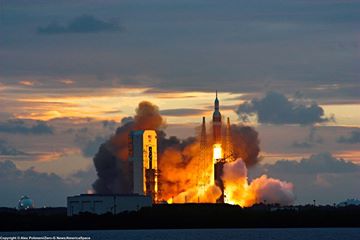
Orion emerged from its second passage through the Lower Van Allen Belt and at 11:21:19 a.m. the spacecraft hit “Entry Interface” at an altitude of 400,000 feet (75 miles or 122 km), during which time it endured temperatures as high as 2,200 degrees Celsius (4,000 degrees Fahrenheit) on its airframe. This temperature is about 80 percent as hot as Orion would experience during a return from lunar distance and represented the most challenging test of the capabilities of its heat shield currently possible. Shortly after Entry Interface, the superheated region of plasma around the Crew Module blocked out communications for about 150 seconds.
Maximum re-entry heating was reached a couple of minutes later and after passage through the worst of this furnace Orion’s Forward Bay Cover was jettisoned to expose its parachutes. Two drogues were deployed at an altitude of 22,000 feet (6,700 meters) and a velocity of 300 mph (480 km/h), helping to slow the Crew Module down to around 100 mph (160 km/h). Ninety seconds later, at 11:27:18 a.m., three pilot chutes pulled out Orion’s trio of massive main canopies at an altitude of 6,500 feet (2,000 meters). Covering the area the size of a football field when deployed, the main parachutes unfurled in a “staged” fashion, firstly to 3-percent-open, then 10-percent-open, and eventually to fully open. This technique has been developed to keep the aerodynamic forces on the canopies to a minimum, providing for a softer descent and ensuring the safety of the hardware. Even if one parachute fails, the system has the potential to slow the 19,000-pound (8,600 kg) Crew Module to a splashdown at just 17 mph (27 km/h).
As expected, the EFT-1 mission ended in the Pacific Ocean, about 600 miles (965 km) off the coast of Baja California, far to the south-west of San Diego, and splashdown occurred a little before 11:30 a.m. EST (8:30 a.m. PST), after a journey of 4.5 hours. Orion’s uprighting system inflated to achieve a heads-up orientation and it remained powered-up after hitting the waters of the ocean. The retrieval effort required the combined efforts of a joint NASA-Navy team. Flight Director Mike Sarafin contacted Recovery Director Jeremy Graeber, aboard the USS Anchorage to advise him of the spacecraft’s overall health and status after a journey of more than 60,000 miles (96,600 km).
Stunning view of the sight and sound of the Delta IV Heavy delivering Orion on its maiden voyage. Video Credit: Alex Polimeni/Zero-G News/AmericaSpace
Also supporting the EFT-1 landing was the Navy’s salvage ship, USNS Salvor. Small Zodiac boats were deployed to attach a sea anchor, load-distributing collar and tether lines, after which they began towing operations into the Anchorage’s well deck. “The Crew Module will be winched into the flooded well deck and placed on rubber shock absorbers,” noted NASA’s EFT-1 press kit. “Water will be drained from the well deck, leaving Orion secure and dry. Once the ship starts the journey back to shore and reaches calm waters, the Crew Module then will be placed into its recovery cradle and readied for offloading.”
Meanwhile, the Salvor’s cranes lifted the Forward Bay Cover and parachutes from the ocean onto the deck and all hardware is currently in transit to a pier at the U.S. Naval Base San Diego, where it is available for media to view on Monday, 8 December. The Crew Module will then be driven by truck to the Kennedy Space Center (KSC), where it will be refurbished and used in Orion’s Ascent Abort (AA-2) test in 2018.
Check back Sunday for a gallery story with all the imagery & pad video captured by our imagery team.
Want to keep up-to-date with all things space? Be sure to “Like” AmericaSpace on Facebook and follow us on Twitter: @AmericaSpace
Missions » SLS » EFT-1 » Missions » SLS »



5 Comments
5 Pings & Trackbacks
Pingback:Voyages Iles | cardebtor.com
Pingback:Voyages Iles | bosscampaigns.com
Pingback:Voyages Iles | hotellyon.tk
Pingback:Voyages Iles | hotelbarcelone.tk
Pingback:After EFT-1, Orion Crew Module Subjected to Intense Heat Shield Inspections « AmericaSpace